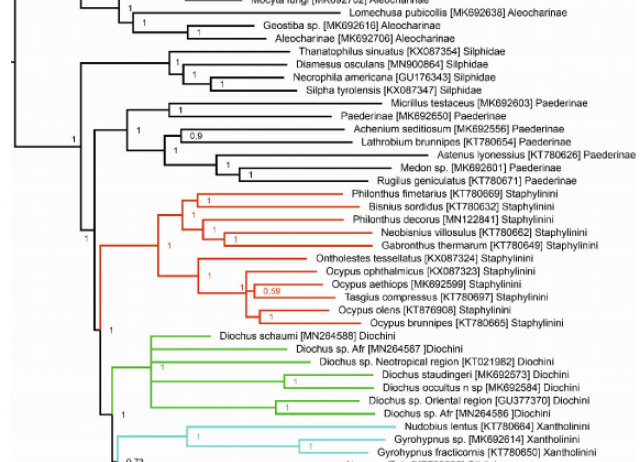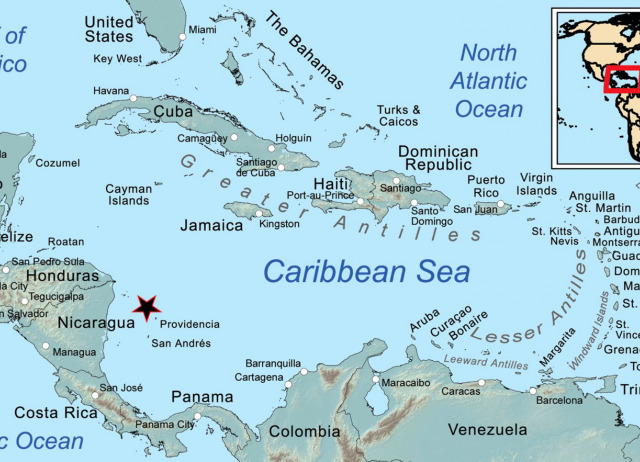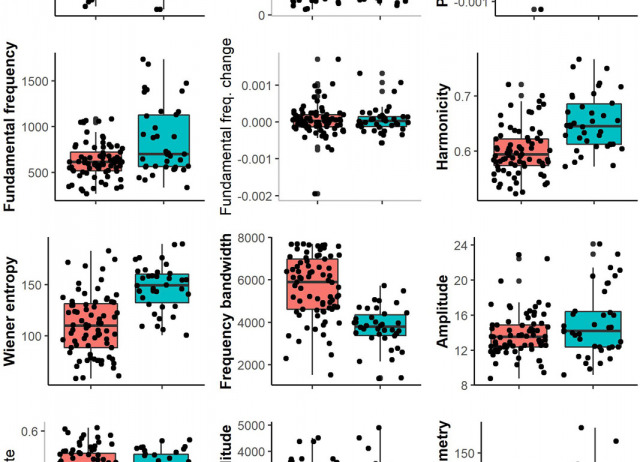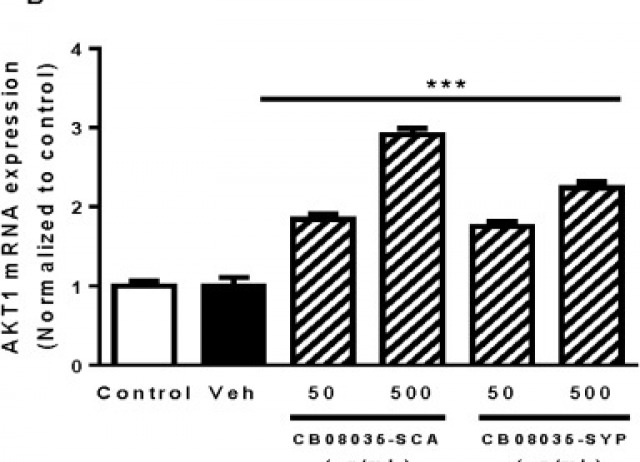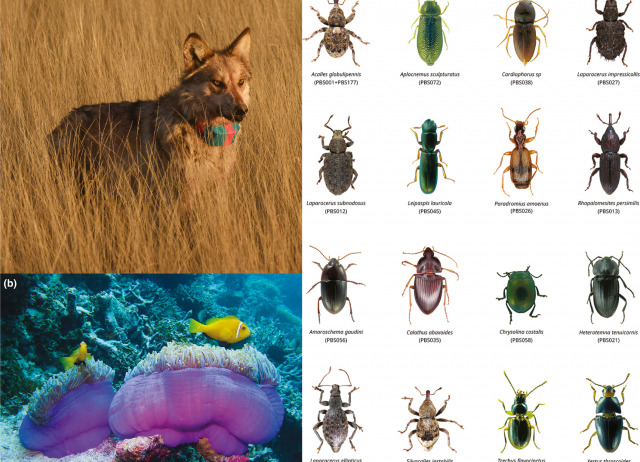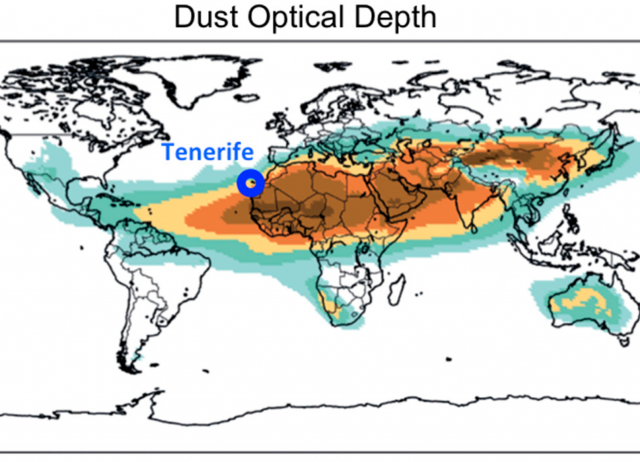Prorocentroic Acid, a Neuroactive Super-Carbon-Chain Compound from the Dinoflagellate Prorocentrum hoffmannianum
Prorocentroic acid (PA) was isolated from the dinoflagellate Prorocentrum hoffmannianum. Relative configurations for its 35 asymmetric centers, were determined by analysis of NMR data including heteronuclear couplings and quantum mechanical calculations. PA was tested by using murine cortical neurons grown on microelectrode-arrays. Long term exposure to subtoxic concentrations induced a significant reorganization of neuronal signaling, mainly by changes in the bursting activity. The observed effects could be due to the activation of a plasticity process.
Domínguez, Humberto J.; Cabrera-García, David; Cuadrado, Cristina; Novelli, Antonello; Fernández-Sánchez, M. Teresa; Fernández, José J.; Hernández Daranas, Antonio
Mitogenomic phylogenetics of Diochus occultus n. sp., a palaeoendemic endogean species within the tribe Diochini (Coleoptera: Staphylinidae: Staphylininae)
The tribe Diochini has a worldwide distribution, with 2 and 74 epigean species within the genera Antarctothius and Diochus respectively. Recent phylogenetic studies suggest a sister relationship of Diochini and a lineage formed by Xantholinini, Maorothiini, and Othiini, within the subfamily Staphylininae. Here we describe the first known endogean representative of Diochini, Diochus occultus n. sp., and provide the first two complete mitogenomes for the tribe, corresponding to the two European Diochus species: Diochus occultus n. sp. and Diochus staudingeri. These sequences were combined with 40 additional mitogenomes from representatives within Staphylininae, Paederinae, Silphidae, and Aleocharinae, and COI sequences from 5 additional species of Diochus to conduct a series of mitogenomic phylogenetic and dating analyses. The estimated molecular phylogeny is fully consistent with previous studies based on morphology and molecular data, finding a sister relationship of Diochini with a clade formed by Xantholinini and Othiini (Maorothiini not sampled). Dating analyses inferred an early split of the tribe Diochini at 140-156 Mya. Morphology shows clear differences in the aedeagal and external morphology of D. occultus n. sp. and D. staudingeri, whereas a sister relationship of these taxa is found in the phylogenetic analyses, with the split dated at 48-61 Mya. Although the study of additional Palaearctic Diochus species will be required to conclusively establish that D. occultus n. sp. is a palaeoendemic taxon sister to D. staudingeri, associated to forests of Abies pinsapo in the south of the Iberian Peninsula, this conclusion is consistent with the ancient estimated age of speciation, endogean habitat specificity, low dispersal capacity (flightless species), and microendemicity of D. occultus. This is also consistent with the continued emersion of the Betic sub-plate along its tectonic evolution. The estimated ages of diversification of the Paederinae-Staphylininae lineage are also discussed.
Hernando, Carles; Andújar, Carmelo
Equality and Hierarchy, Sovereignty and Multiculturalism: the Heritagisation of Raizals in Santa Catalina (Colombia)
Santa Catalina is a Caribbean island in the Colombian archipelago of Providencia y San Andrés, which has been at the center of a recent territorial dispute between Colombia and Nicaragua that has made the islands central to the geostrategic agenda of the Colombian state in its attempt to reaffirm political alliances with the United States. Within this context, our investigation explores recent processes of archaeological research, heritagisation and tourism promotion on Santa Catalina Island that triggered a conflict between the local raizal population (Afro-descendant, Caribbean, Puritan and English-speaking) and the State (white, Andean, Catholic and Spanish-speaking) around the meaning of two key sites of memory—Fuerte Libertad (Fort Warwick) and the Cabeza de Morgan (Morgan's Head). Drawing on long-term ethnography, this paper reveals how the neoliberal, multicultural state of Colombia has functioned as an investment facilitator and a key actor in transforming ethnic-racial differences into class inequalities.
Alonso-González, Pablo; Londoño, Wilhelm; Parga-Dans, Eva
Cryptic differentiation in the Manx Shearwater hinders the identification of a new endemic subspecies
The taxonomy of Procellariiformes, particularly petrels and shearwaters, is still unresolved. The Manx shearwater Puffinus puffinus is one of the best studied seabirds worldwide. Most of the information known on this seabird is focused on the northern core populations where the species is abundant. However, the species shows a high number of peripheral populations, which are extremely small and difficult to study in comparison to central populations. Using an integrative approach, we provided significant evidence of phenological, morphological, acoustic, plumage colour, and genetic differentiation of the Canarian Manx shearwaters (the most southern population) from the northern breeding colonies, which is compatible with a long period of isolation. Birds from the Canary Islands breed around 2‐3 months earlier, are smaller and lighter, and show darker underwing plumage than those from northern populations. In addition, Canarian call features are different from the northern populations. Finally, genetic analyses of the mitochondrial control region indicate an incipient genetic differentiation of Canarian Manx shearwaters from the other breeding populations. The Canarian population holds a small number of breeding colonies and it is declining, so accurate taxonomic recognition critically affects conservation efforts. For all the aforementioned reasons, we propose to rank the Canarian breeding population as a new taxon by presenting the formal description of a new subspecies Puffinus puffinus canariensis ssp. nova.
Rodríguez, Airam; Rodríguez, Beneharo; Montelongo, Tinguaro; García-Porta, Joan; Pipa, Tania; Carty, Martin; Danielsen, Jóhannis; Nunes, Joâo; Silva, Carlos; Geraldes, Pedro; Medina, Félix M.; Illera, Juan Carlos
El Vino “Natural”: Alimento, Cultura, Tradición, Patrimonio y… ¡Salud!
Según la Ley de la Viña y el Vino, éste “es el alimento natural obtenido exclusivamente por fermentación alcohólica, total o parcial, de uva fresca, estrujada o no, de mosto de uva” (Art. 2 Ley 24/2003, Gobierno de España). La RAE, en su séptima acepción de “natural” como adjetivo, define aquello “Que se produce por solas las fuerzas de la naturaleza, como contrapuesto a sobrenatural y milagroso”. Por tanto, la relación entre vino y alimento queda establecida en el marco normativo y definitorio español. Sin embargo, el vino continúa siendo el único producto alimentario no sujeto a regulación de etiquetado en cuanto a ingredientes y aditivos en todo el mundo. Ante esta tesitura comenzamos nuestra línea de investigación sobre vino, patrimonio, alimentación y salud, preguntándonos: ¿es sano/insano cualquier vino independientemente de su proceso productivo y propiedades organolépticas?, ¿son estos factores tenidos en cuenta en la certificación de la calidad del vino? La respuesta inmediata es que es imposible saberlo. ¿Cuáles son las consecuencias de esta situación anómala, y qué podemos hacer desde la investigación aplicada?
Parga-Dans, Eva; Alonso-González, Pablo
Protective effects of culture extracts (CB08035-SCA and CB08035-SYP) from Marinobacter hydrocarbonoclasticus (strain CB08035) against oxidant-induced stress in human colon carcinoma Caco-2 cells
The present study investigated the effect of culture extracts (CB08035-SCA and CB08035-SYP) from Marinobacter hydrocarbonoclasticus (strain CB08035) on cell viability and the potential protective effects attributed to molecular mechanisms underlying antioxidant response to survive oxidative stress injuries. Caco-2 cells were submitted to oxidative stress by treatment with tert-butyl hydroperoxide (t-BOOH). Both extracts prevented cell damage and enhanced activity of antioxidant defenses (NQO1 and GST activities and GSH levels) reduced by treatment with t-BOOH. Increased ROS and caspase 3/7 activity induced by t-BOOH were dose-dependently prevented when cells were treated with the extracts. CB08035-SCA caused up-regulation of Nrf2, AKT1 and Bcl-2 gene expressions. Moreover, CB08035-SCA and CB08035-SYP treatments reduced significantly Bax, BNIP3, APAF1, ERK1, JNK1, MAPK1, NFκB1, TNFα, IL-6, IL-1β and HO-1 gene expressions of apoptosis, proinflammation and oxidative stress induced by t-BOOH. CB08035-SCA and CB08035-SYP CPE extracts confer a significant protection against oxidative insults to cells. Our results show that culture extracts CB08035-SCA and CB08035-SYP from M. hydrocarbonoclasticus (strain CB08035) appeared to have antioxidant potential, based on their ability to protect antioxidant enzymes and mRNA gene expressions linked to apoptosis/oxidative pathways. These results suggest that culture extracts CB08035-SCA and CB08035-SYP can be a potential ingredient in the pharmaceutical and cosmeceutical industries.
Martínez, María-Aránzazu; Ares, Irma; Martínez, Marta; López-Torres, Bernardo; Rodríguez, José-Luis; Maximiliano, Jorge-Enrique; Martínez-Larrañaga, María-Rosa; Anadón, Arturo; de la Rosa, José-Manuel; Cueto, Mercedes
Building a global genomics observatory: Using GEOME (the Genomic Observatories Metadatabase) to expedite and improve deposition and retrieval of genetic data and metadata for biodiversity research
Genetic data represent a relatively new frontier for our understanding of global biodiversity. Ideally, such data should include both organismal DNA‐based genotypes and the ecological context where the organisms were sampled. Yet most tools and standards for data deposition focus exclusively either on genetic or ecological attributes. The Genomic Observatories Metadatabase (GEOME: geome‐db.org) provides an intuitive solution for maintaining links between genetic data sets stored by the International Nucleotide Sequence Database Collaboration (INSDC) and their associated ecological metadata. GEOME facilitates the deposition of raw genetic data to INSDCs sequence read archive (SRA) while maintaining persistent links to standards‐compliant ecological metadata held in the GEOME database. This approach facilitates findable, accessible, interoperable and reusable data archival practices. Moreover, GEOME enables data management solutions for large collaborative groups and expedites batch retrieval of genetic data from the SRA. The article that follows describes how GEOME can enable genuinely open data workflows for researchers in the field of molecular ecology.
Riginos, Cynthia; Crandall, Eric D.; Liggins, Libby; Gaither, Michelle R.; Ewing, Rodney B.; Meyer, Christopher; Andrews, Kimberly R.; Euclide, Peter T.; Titus, Benjamin M.; Therkildsen, Nina Overgaard; Salces-Castellano, Antonia; Stewart, Lucy C.; Toonen, Robert J.; Deck, John
Saharan Dust Events in the Dust Belt -Canary Islands- and the Observed Association with in-Hospital Mortality of Patients with Heart Failure
Recent studies have found increases in the cardiovascular mortality rates during poor air quality events due to outbreaks of desert dust. In Tenerife, we collected (2014–2017) data in 829 patients admitted with a heart failure diagnosis in the Emergency Department of the University Hospital of the Canaries. In this region, concentrations of PM10 and PM2.5 are usually low (~20 and 10 g/m3), but they increase to 360 and 115 g/m3, respectively, during Saharan dust events. By using statistical tools (including multivariable logistic regressions), we compared in-hospital mortality of patients with heart failure and exposure to PM10 and PM2.5 during dust and no-dust events. We found that 86% of in-hospital heart failure mortality cases occurred during Saharan dust episodes that resulted in PM10 > 50 g/m3 (interquartile range: 71–96 g/m3). A multivariate analysis showed that, after adjusting for other covariates, exposure to Saharan dust events associated with PM10 > 50 g/m3 was an independent predictor of heart failure in-hospital mortality (OR = 2.79, 95% CI (1.066–7.332), p = 0.03). In conclusion, this study demonstrates that exposure to high Saharan dust concentrations is independently associated with in-hospital mortality in patients with heart failure.
Dominguez-Rodriguez, Alberto; Baez-Ferrer, Néstor; Rodríguez, Sergio; Avanzas, Pablo; Abreu-Gonzalez, Pedro; Terradellas, Enric; Cuevas, Emilio; Basart, Sara
O Antipatrimónio: Fetichismo do Passado e Dominação do Presente
O património é hoje uma palavra na boca de todos. Foi criado por nações e instituições, estudado por intelectuais e cientistas, criticado pela sua capacidade de gerar conflitos em relação à identidade e à memória. Tem sido mercantilizado globalmente com base em critérios semelhantes, da Tailândia à Bolívia. Mas essas investigações partiram principalmente do pressuposto de que o património é algo dado, bom e valioso em si mesmo e que sempre existiu. Por isso, o conceito de património não tem sido questionado como categoria, ou seja, como forma de relação própria das sociedades fetichistas e, portanto, historicamente determinada e com raízes histórico-culturais intrinsecamente ligadas ao surgimento e expansão do capitalismo e à epistemologia do iluminismo, moderna e ocidental. Este livro propõe uma crítica à categoria «património» a partir de uma etnografia da região de Maragatería, Espanha. A etnografia analisa empiricamente as transformações e processos que levam, ou não, o património a existir entre os maragatos.
Alonso-González, Pablo.
Long‐term cloud forest response to climate warming revealed by insect speciation history
Montane cloud forests are areas of high endemism, and are one of the more vulnerable terrestrial ecosystems to climate change. Thus, understanding how they both contribute to the generation of biodiversity, and will respond to ongoing climate change, are important and related challenges. The widely accepted model for montane cloud forest dynamics involves upslope forcing of their range limits with global climate warming. However, limited climate data provides some support for an alternative model, where range limits are forced downslope with climate warming. Testing between these two models is challenging, due to the inherent limitations of climate and pollen records. We overcome this with an alternative source of historical information, testing between competing model predictions using genomic data and demographic analyses for a species of beetle tightly associated to an oceanic island cloud forest. Results unequivocally support the alternative model: populations that were isolated at higher elevation peaks during the Last Glacial Maximum are now in contact and hybridizing at lower elevations. Our results suggest that genomic data are a rich source of information to further understand how montane cloud forest biodiversity originates, and how it is likely to be impacted by ongoing climate change.
Salces-Castellano, Antonia; Stankowski, Sean; Arribas, Paula; Patiño, Jairo; Karger Dirk N.; Butlin, Roger; Emerson, Brent C.
